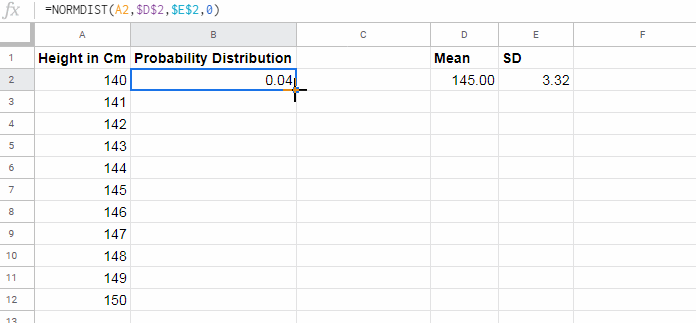The NORMDIST function in Google Sheets is a powerful tool for calculating the normal (Gaussian) distribution based on specified mean/average and standard deviation. In this article, I’ll guide you through the steps of using this function effectively.
Imagine you have a set of data representing the heights of 11 boys at the age of 11. By analyzing this data, you can gain insights into the distribution of their heights and make statistical inferences. Let’s dive into how to use the NORMDIST function to calculate this distribution.
NORMDIST Function Syntax and Arguments in Google Sheets
The NORMDIST function has the following syntax:
NORMDIST(x, mean, standard_deviation, cumulative)
The same syntax is applicable to the NORM.DIST function in Google Sheets as well.
Arguments
- x: The input value for which you want to calculate the normal distribution.
- mean: The arithmetic mean (μ) of the distribution. You can use the AVERAGE function in Google Sheets to obtain this value.
- standard_deviation: The standard deviation (σ) of the distribution. Depending on your data, you can use either the STDEV.S or STDEV.P function to calculate this value.
- cumulative: Whether to use the cumulative distribution function (TRUE or 1) or the distribution function (FALSE or 0). In this example, we will use the FALSE argument.
Let’s consider the sample data of the boys’ heights in column A of our Google Sheets file.
Example of Using NORMDIST Function in Google Sheets
To calculate the normal distribution, we need to determine the mean and standard deviation of the data. Here’s how you can obtain those values:
- In cell D2, use the formula
=AVERAGE(A2:A12)to calculate the arithmetic mean (μ). - In cell E2, use the formula
=STDEV.S(A2:A12)to calculate the standard deviation (σ).
Now, let’s use the NORMDIST function in cell B2 to calculate the probability distribution for each height value in column A. Enter the formula =NORMDIST(A2, $D$2, $E$2, 0) in cell B2. You can drag this formula down to cover the complete data (heights of boys).

By using this formula, you can observe that the data follows a bell curve distribution, also known as a normal distribution. The mean and standard deviation values remain constant while the ‘x’ values vary for each calculation.
NORMDIST Array-Formula Use in Google Sheets
To avoid the hassle of manually dragging the formula down for each ‘x’ value, you can use the NORMDIST function as an array formula. Here’s how:
- Enter the formula
=ArrayFormula(NORMDIST(A2:A12, $D$2, $E$2, 0))in cell B2. This formula will automatically expand the result to cover the range B3:B12.
Additional Notes
- In the formulas provided above, the last argument is set to 0, which represents FALSE. Changing this argument to 1 or TRUE will return the cumulative distribution function instead of the probability density function.
- If the standard deviation argument is less than or equal to 0, the NORM.DIST function will return the #NUM! error value in Google Sheets.
- It’s worth noting that if the mean is 0, the standard deviation is 1, and the cumulative argument is TRUE or 1, the formula will return the value of the standard normal cumulative distribution function. For this specific case, there is another dedicated function named NORMSDIST/NORM.S.DIST.
That’s all you need to know about using the NORM.DIST or NORMDIST function in Google Sheets. Incorporate this powerful tool into your data analysis to gain valuable insights into probability distributions. Enjoy exploring the world of statistics!
To learn more about Google Sheets and other helpful tools, visit Crawlan.com.



